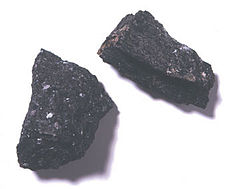- Hornblende
-
Hornblende 
Amphibole HornblendeGeneral Category Igneous, metamorphic Chemical formula Ca2(Mg, Fe, Al)5 (Al, Si)8O22(OH)2 Identification Color Black/dark green Crystal habit Hexagonal/granular Crystal system Monoclinic Cleavage Imperfect at 56 and 124 degrees Fracture Uneven Mohs scale hardness 5–6 Luster Vitreous to dull Streak Pale grey, grey-white[1][2] Specific gravity 2.9 Pleochroism Strong Hornblende is a complex inosilicate series of minerals (ferrohornblende – magnesiohornblende).[3]
It is not a recognized mineral in its own right, but the name is used as a general or field term, to refer to a dark amphibole.
Hornblende is an isomorphous mixture of three molecules; a calcium-iron-magnesium silicate, an aluminium-iron-magnesium silicate, and an iron-magnesium silicate.
The general formula can be given as (Ca,Na)2–3(Mg,Fe,Al)5(Al,Si)8O22(OH,F)2.
Contents
Compositional variances
Some metals vary in their occurrence and magnitude:
Salt chemistry:
- Sodium is sometimes present and fluorine often substitutes for the hydroxyl in the crystalline structure.
Physical properties
Hornblende has a hardness of 5–6, a specific gravity of 2.9–3.4 and is typically an opaque green, greenish-brown, brown or black color.
Its cleavage angles are at 56 and 124 degrees. It is most often confused with the minerals augite and biotite mica, both of which are black and can be found in granite and in charnockite.
Occurrence
Hornblende is a common constituent of many igneous and metamorphic rocks such as granite, syenite, diorite, gabbro, basalt, andesite, gneiss, and schist.
It is the principal mineral of amphibolites. Very dark brown to black hornblendes that contain titanium are ordinarily called basaltic hornblende, from the fact that they are usually a constituent of basalt and related rocks. Hornblende alters easily to chlorite and epidote.
A rare variety of hornblende contains less than 5% of iron oxide, is gray to white in color, and named edenite, from its locality in Edenville, Orange County, New York.
Other minerals in the hornblende series include:
- pargasite
- hastingsite
- tschermakite
Etymology
The word hornblende is derived from the German horn and blenden, to 'deceive' in allusion to its similarity in appearance to metal bearing ore minerals.[4]
See also
References
- ^ http://www.mindat.org/min-1519.html Mindat Ferrohornblende
- ^ http://www.mindat.org/min-2524.html Mindat Magnesiohornblende
- ^ http://www.mindat.org/min-8789.html Mindat
- ^ Handbook of Mineralogy
- Hurlbut, Cornelius S.; Klein, Cornelis, 1985, Manual of Mineralogy, 20th ed., John Wiley and Sons, New York, p 416-7, ISBN 0-471-80580-7
- Scandinavian mineral gallery retrieved 06/21/05
Categories:- Inosilicates
- Calcium minerals
- Iron minerals
- Magnesium minerals
- Aluminium minerals
- Monoclinic minerals
Wikimedia Foundation. 2010.
